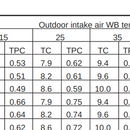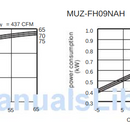What is incremental power needed to raise house temp a few degrees with Mitsubishi minisplits?
I have an all-electric house in MA heated exclusively with two MUZ-FH09NAH ( ductless minisplit with pan heater). This is my first heating season so I am still on a learning curve and am desirous to optimize my costs and comfort.
I was pleasantly surprised to find that the Mitsubishis generated heat even as the thermometer plummeted to minus 7.6 F a few weeks ago. We keep them set to 64 degrees indoor but want to know what incremental power consumption would be incurred if we raised temp to 66 or 68 degrees. In order to answer this, I tried to use the manufacturer documentation, linked at the following URL, specifically the table on page 14 and the graphs on page 16, screenshots will be attached.
https://www.manualslib.com/manual/908936/Mitsubishi-Electric-Muz-Fh09na.html
Reading the heating tables has been frustrating and counterintuitive so I hope for some GBA guidance. I am looking to optimize TPC (total power consumption in kwh).
1. Looking at table on page 14, it looks like TPC is less than 5% higher for raising indoor temp from 65 to 70 degrees (TPC @ 65 of .62 versus TPC @ 70 of .64). That seems a very reasonable increment.
2. It is counterintuitive (for me) to see that TPC *increases* as outdoor intake air temp increases. Shouldn’t the indoor heating TPC be *less* when the outdoor temp is 55 (TPC = .74) degrees than it is when the temp is 35 (TPC = .66)? I realize that the delta temp magnitude drives the heating engine, but my ears tell me that the duty cycle (ie when the outdoor unit is working hard) is more frequent at 35 than 55. Will my Spring heating bills actually be higher than my Winter ones?
3. My confusion is reinforced by what looks to me like an axis error for the graph of FH09NA, which shows the 65 degree interior temp has a *higher* TPC than 75 temp, while the opposite is shown for the FH09NAH graph. I think the typo is on the latter graph, no?
A brief primer on how to understand these tables would be helpful to me.
Thanks, everyone.
GBA Detail Library
A collection of one thousand construction details organized by climate and house part











Replies
Kenneth, the Mitsubishi documentation isn’t going to tell you the answer to your question. The energy required to raise the temperature is a bit unique to your particular house and heat pump installation. I suggest measuring it with an energy monitor. Here’s my favorite: https://stuff.iotawatt.com/
Increasing the indoor temperature will:
1. Increase the heat load--the amount of heat needed. If you've got a 7o degree indoor/outdoor temperature difference, a first-order estimate is that raising the indoor temperature will increase the heat load by 10% if you increase it by 7 degrees.
2. Decrease the output of the heat pump, when it's running at maximum.
3. Decrease the input power of the heat pump, when it's running at maximum.
If the effects 2 and 3 where the same size, they cancel out and wouldn't affect the total energy consumption, and only effect 1 would matter. But the decrease in heat output is bigger than the decrease in power consumption. So those two make things a little worse as well.
The net result of 2 and 3 is rolled in to the COP. So if you look at the data for COP, and combine that with effect 1., you'd get a reasonable estimate.
" If you've got a 7o degree indoor/outdoor temperature difference, a first-order estimate is that raising the indoor temperature will increase the heat load by 10% if you increase it by 7 degrees."
Under that logic, would it increase less if he used the metric system?
Here's how to estimate it: find out the length of your heating season, in days. Multiply that by 4 degrees to get the annual increase in degree-days. Find out how many degree-days your location averages per year. Calculate the percent change.
I don't think there is going to be a measurable change in the efficiency of a heat pump changing the interior temperature by 4F.
It was minus 44 F in International Falls, MN this morning and coming your way. You may have time to upgrade your electrical panel. Let us know how the minisplits do in the days ahead, I am amazed at the advancement in heat pump technology, exciting stuff.
> Will my Spring heating bills actually be higher than my Winter ones?
The total power consumption (TPC) they list is a maximum and should not be confused with the power consumption that you will pay for. Your spring bills will be lower - mostly because load is lower and partially because efficiency is higher.
To determine the incremental power needed to raise your house temperature house temperature with Mitsubishi minisplits, you need to consider the heat load, which is the amount of heat required to achieve your desired temperature increase. The heat load depends on factors like the temperature difference between indoors and outdoors. For example, if you have a 70-degree Fahrenheit difference, it will require a certain amount of power to bridge that gap.
Unfortunately, the specific power consumption can vary based on factors like the size and efficiency of your Mitsubishi minisplit unit, the insulation of your home, and the desired temperature increase. To get an accurate estimate, it's best to consult the manufacturer's specifications for your particular minisplit model and consider factors like insulation and outdoor conditions. You may also want to consult a professional HVAC technician for a more precise calculation tailored to your home's specific requirements.